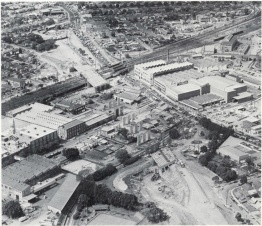The widening of the M4 motorway at Homebush and extension of the motorway from Strathfield to the City West link is the next stage in the continuing development of Sydney’s Western Expressway. This road has been known as the F4 Western Freeway, M4 Motorway and is now part of the current WestConnex Project. It is astonishing to learn that the origins of this project date back nearly 70 years. This is a brief summary of previous plans and works.
In 1947, planning for the Western Expressway commenced as the County of Cumberland Planning Scheme was being prepared. The scheme outlined a Western Freeway plan linking the central business district of Sydney to Penrith then on to the state’s west via The Blue Mountains.
In 1951, the skeleton of this system was incorporated as part of the county of Cumberland Planning Scheme adopted by the NSW Parliament in 1951.
In the original plan the road ran from Sydney to the Great Western Highway at Lapstone, passing through Glebe, Haberfield, and Five Dock before joining the current route at Strathfield. In the early 1970s, the first section between Prospect to Penrith was completed. The more difficult section was the next stage from Strathfield passing through Homebush, which involved acquisition of land and houses in streets such as Underwood Road, Wentworth Street and Short Street Homebush.
One of these houses was ‘Pomeroy House’ (formerly ‘Laira’) in Wentworth Road, a grand Victorian mansion built for John Pomeroy in the 1880s. Pomeroy was a partner of retailer David Jones. Pomeroy Street in Homebush is named after John Pomeroy. Bill Boyce Reserve in Pomeroy Street was formerly known as Pomeroy Reserve but renamed Bill Boyce, in memory of a former Mayor.
The National Trust classified Pomeroy House in the early 1970’s but it was demolished amid much controversy to make way for the F4 Expressway. The demolition of this house highlighted the absence of legislative protection for historic properties in NSW. The first Heritage Act in NSW was implemented in 1977.
Construction commenced in 1971 on the eastern end at Saleyards Creek, Homebush and James Ruse Drive Granville which mainly involved construction of bridgeworks to carry the expressway over existing roadways. Twelve bridges were completed by mid-1977 and a further twelve between 1978 and 1982. This included a cable-stayed, steel box-girder pedestrian bridge at Pomeroy Street Homebush, the first of its type in NSW. The bridge  uses cables, running from a tower above the bridge to given additional support to bridge spans. This enables much longer spans to be used without the need for additional supporting piers. The bridge has two spans with a total length of 67.6 metres. This bridge provides bicycle and pedestrian access across the expressway (now M4) and is part of the Bay-to-Bay pathway from Botany Bay to Homebush running mainly along the Cooks River. The section of the expressway which travels over George Street Homebush and the northern railway between Strathfield and North Strathfield rail stations is a 336 metre, 12 span viaduct.
uses cables, running from a tower above the bridge to given additional support to bridge spans. This enables much longer spans to be used without the need for additional supporting piers. The bridge has two spans with a total length of 67.6 metres. This bridge provides bicycle and pedestrian access across the expressway (now M4) and is part of the Bay-to-Bay pathway from Botany Bay to Homebush running mainly along the Cooks River. The section of the expressway which travels over George Street Homebush and the northern railway between Strathfield and North Strathfield rail stations is a 336 metre, 12 span viaduct.
The building of the expressway involved changed alignments and names in Homebush. Short Street was divided and become Short Street east and Short Street west. Wentworth Street was divided by the Expressway and properties located south of the expressway on Wentworth Street were renumbered and the street was renamed Park Road.
The F4 Western Freeway from Strathfield to Auburn was opened on 16 December 1982 by the NSW Premier Neville Wran. Though the road was originally planned to continue to Sydney, on the basis of a pre-election promise made by the Premier of NSW Neville Wran in 1976, all land reserved for the expressway between Pyrmont and the current eastern termination point at Strathfield was sold off to property developers or declassified as a freeway corridor in 1977 by the State Government. However, while no doubt this decision was popular to residents affected by the proposed freeway, the abrupt termination of the expressway at Parramatta Road Strathfield created a major traffic bottleneck at Strathfield and a significant gap in Sydney’s major road networks, especially between Strathfield and Five Dock/Haberfield, where the City West Link commences.






Very interesting! Many thanks, Alex.
LikeLike